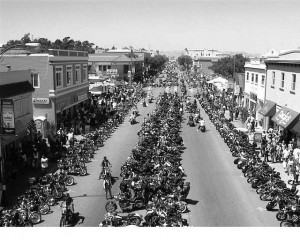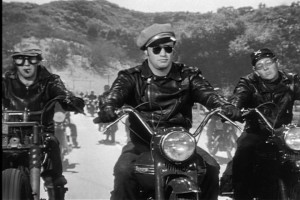When you think of a biker, what do you think of? Most people imagine a big, burly man with a large beard and tattoos all over him. He's probably loud and says something rude or vaguely threatening. He wears all leather, a t-shirt with a bike on it, a jacket covered in patches, and a pair of sunglasses. However, this stereotypical biker image, no matter how prevalent it is, is actually pretty outdated. Bikers might have looked like this 30 years ago, but it's not the truth anymore. Today's bikers don't have a look, anyone you see on the street might be walking to their Harley.
So where did this stereotype of big, scary men and butch women bikers come from? Of course, there are bikers who fit this image, but they were more prevalent decades ago. There were fewer bikers during that time, so those who fit this image made up a larger percentage of riders. These bikers were used as the main image of motorcycle riders by the media at the time, partly as a way of making bikers look horrible.
Gypsy Tour Motorcycle Rally
 One of the main sources of the biker stereotype came from Life Magazine. The magazine wrote an article about the riot in Hollister, California, that occurred between July 3 and July 6, 1947. The town was the site for the Gypsy Tour motorcycle rally, a rally officially sanctioned by the American Motorcyclist Association and planned as a normal biker gathering. The events of the 'riot' that occurred during the rally were greatly exaggerated by Life Magazine and other publications.
One of the main sources of the biker stereotype came from Life Magazine. The magazine wrote an article about the riot in Hollister, California, that occurred between July 3 and July 6, 1947. The town was the site for the Gypsy Tour motorcycle rally, a rally officially sanctioned by the American Motorcyclist Association and planned as a normal biker gathering. The events of the 'riot' that occurred during the rally were greatly exaggerated by Life Magazine and other publications.
The event did get out of hand, however. There were many more bikers at the rally than expected. Almost 4,000 people showed up, which was twice the population of Hollister. While the town at first welcomed the huge number of guests because of the money they brought, things soon got out of hand. Drunk bikers began racing down the streets at all hours of the night, yelling, and even fighting. Some bars were damaged, and broken beer bottles littered the streets. The small town police force was called in, and bars were instructed to close early and stop selling beer to those who were obviously drunk.
While people in town were quoted as saying that the bikers made a huge mess and were being very loud, they didn't actually cause any harm. There was some minor damage to stores, and about 50 people were charged with public intoxication, disturbing the peace, and reckless driving. There were some injuries, too, all of which were incurred by bikers. No Hollister residents were hurt.
Life Magazine made it sound like the town was mostly destroyed and that the crazy bikers hurt residents. While neither Life nor any other publication outright lied about the events that occurred, they certainly skewed them negatively. Headlines like 'Havoc in Hollister' were splashed across papers, and the event was described as being pandemonium. The photos that were included in many of these articles, including the Life Magazine article, were staged to make it look like motorcyclists were causing a huge amount of damage.
The Wild One
 The biker stereotype was reinforced a decade later with the movie The Wild One, which was based on a story by author Frank Rooney. This story was actually a much-fictionalized version of the Hollister event. The movie was released in 1953, starring Marlon Brando as Johnny Strabler, a wild motorcycle club leader. His group, the Black Rebels Motorcycle Club, roars into the peaceful town of Wrightsville, California, and turn it upside down. His bad boy, rebel without a cause image attracts the attention of Kathie, a young local girl, which causes some trouble with her family. After the Black Rebels have a fight with a rival motorcycle group, the town ends up trashed.
The biker stereotype was reinforced a decade later with the movie The Wild One, which was based on a story by author Frank Rooney. This story was actually a much-fictionalized version of the Hollister event. The movie was released in 1953, starring Marlon Brando as Johnny Strabler, a wild motorcycle club leader. His group, the Black Rebels Motorcycle Club, roars into the peaceful town of Wrightsville, California, and turn it upside down. His bad boy, rebel without a cause image attracts the attention of Kathie, a young local girl, which causes some trouble with her family. After the Black Rebels have a fight with a rival motorcycle group, the town ends up trashed.
Even though Johnny is shown to truly love Kathie at the end of the film, he still fits what we now think of as the biker image: he wears a leather jacket, doesn't show respect to many people, and while he doesn't have a beard, he does have long sideburns.
Changing the Image
Combating these negative stereotypes can be difficult. Many people look at a feminine woman or a thin, clean-shaven man and wonder how they can be true motorcycle riders. Fortunately, some of the major motorcycle companies have helped change the face of the modern biker. Honda started it in the 1960s with a series of ads that presented motorcycles as being for everyone, not just a select few. This helped change the image of a rebellious, dangerous biker into a law-abiding, safe motorcyclist.
Of course, the stereotype is not completely gone. If you watch a movie and someone rides up on a bike, you know he's going to be a rebellious bad boy character. The difference, though, is that now we know he is not going to be a dangerous guy. People also understand that there's a reason why bikers look a certain way. Leather jackets, vests, and pants are very durable and help protect bikers from the cold and from getting hurt. Bikers put patches all over their jackets just as a way of showing their personality. The same goes for the way they paint their motorcycles.
The best way of battling this negative stereotype is to be a good example. Show that you're not a crazy biker by driving and acting responsibly. Many motorcycle clubs hold charity events to raise money for specific causes or help around the community. Many go out of their way to show that they are simply normal, everyday people who just happen to like riding motorcycles. That's the easiest way of combating the negative stereotype. The more people learn that anyone can be a biker, the more they'll forget about the horrible image bikers once had.
